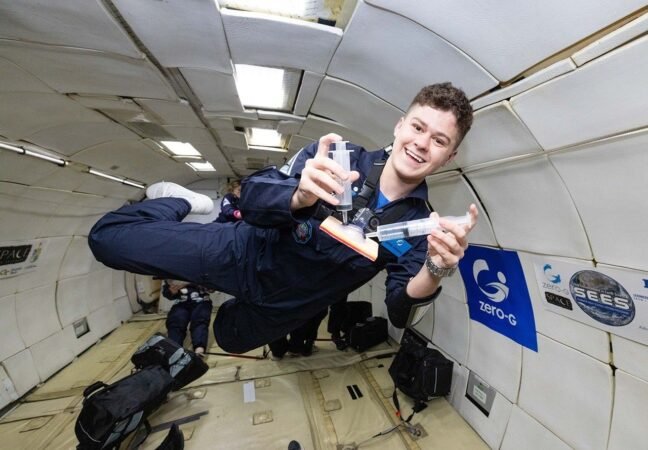Fast Facts
-
Immersive Microgravity Experience: The NASA SEES Summer Intern Program enables high school students to conduct experiments in microgravity aboard the ZERO-G parabolic aircraft, offering 11 minutes of weightlessness.
-
Collaboration for Impact: The initiative is a partnership involving SEES, Space for Teachers, Wisconsin Space Grant Consortium, and CASIS, providing students with essential training in aerospace experiment design and execution.
-
Research Innovations: Four selected interns designed impactful microgravity experiments, focusing on topics like vestibular stimulation, bubble dynamics, propellant slosh damping, and wound irrigation systems, showcasing their skills through rigorous preparation.
- Career Preparation in STEM: This competitive program equips students with hands-on experience in aerospace, spaceflight engineering, and scientific research, fostering future careers while collaborating with NASA and industry experts.
NASA Interns Explore Aerospace Research in Microgravity
NASA’s Science Activation program has opened doors for high school students interested in space research. Through the STEM Enhancement in Earth Science (SEES) Summer Intern Program, students gained hands-on experience in aerospace research. Recently, four interns flew aboard the ZERO-G parabolic aircraft to conduct experiments in microgravity.
This unique program took place in collaboration with several partners, including the University of Texas Center for Space Research and the Wisconsin Space Grant Consortium. Their teamwork allowed the students to design and test experiments in an actual microgravity environment, providing valuable insights into aerospace technologies.
The interns experienced 11 minutes of weightlessness across 30 parabolas. During this time, they conducted studies ranging from how the human body reacts to microgravity to the behavior of bubbles in fluid systems. For example, one intern explored Galvanic Vestibular Stimulation effects, while another investigated thermocapillary-induced bubble dynamics.
Months of preparation led up to this flight. The interns participated in rigorous training that included proposal writing and safety assessments. They collaborated with mentors and implemented engineering protocols similar to those in the industry. This hands-on approach helped them understand the complexities of aerospace research.
Additionally, the interns supported the flight of 12 team-designed experiments integrated into the ZQube platform. This compact research carrier captures valuable data using onboard sensors and cameras, further enriching the students’ learning experience. The ZQube allows over 150 SEES interns nationwide to contribute to scientific investigations in microgravity.
Through this program, participants not only gain technical skills but also receive mentorship from NASA scientists and industry experts. The SEES initiative aims to equip students for careers in aerospace and scientific research. By providing real-world experiences, NASA fosters a new generation of innovators who will shape future technologies.
This summer, SEES intern program participants have truly demonstrated the power of engaging with science. As they explore the unknown, they prepare to help tackle challenges facing our planet and beyond. For students, this experience could spark lifelong interests in space and technology, ultimately benefiting society as a whole.
Expand Your Tech Knowledge
Explore the future of technology with our detailed insights on Artificial Intelligence.
Stay inspired by the vast knowledge available on Wikipedia.
SciV1

